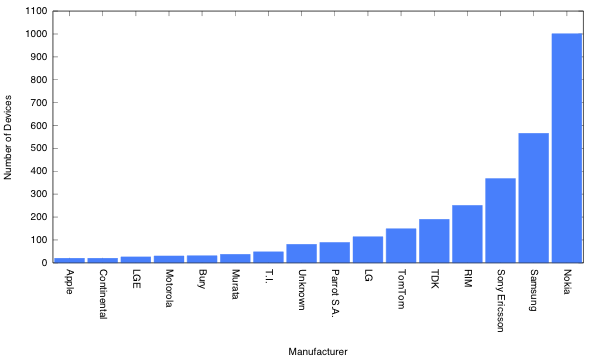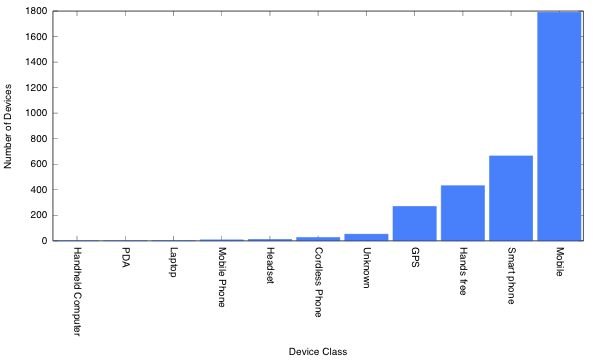Bluetooth Survey January 2011
Feb 28, 2011Last year (in my last post!), I had fun scanning for bluetooth devices on a busy road in Bath, UK (where I happen to live), so this year I decided to repeat the experiment.
This year, instead of running btscanner, which logs results as a directory per
device, I decided to go with running hcitool inq on my debian server, and
catting the results into a text file. This unsophisticated approach has the
advantages that I get timestamps along with my data, and generate less radio
chatter (which was interfering with my wireless network :().
Here’s what I found when I ran my analysis code.
First, like last year, here’s a graph showing the frequency of different manufacturers.

Once again, Nokia, Samsung and Sony Ericsson are top, but this year sees RIM jump in popularity to fourth place (from seventh).
Perhaps the most interesting addition to this year’s graph is ‘Contintenal Automotive Systems’, if I’m correct, these are bluetooth tyre pressure sensors which allow remote inquiries!
Graphing by class shows a similar story to last year as well, although the proportion of ‘smart’ phones and hands free devices has increased.

Finally, since this years' data contains lots of timestamps, I decided to create a time series, showing which classes were visible at any given time. Here’s a time series I made by binning the results into 30 minute intervals, and plotting them as a stacked area graph:

You can clearly see the daily cycle, and it’s pretty easy to tell when there’s most traffic.
I haven’t yet looked at how many of these devices I saw more that once. Bluetooth represents a large and (I believe) completely untapped source of potential tracking data. If I can see and uniquely identify at least one device per minute from my living room, what could a network of bluetooth enabled CCTV cameras, distributed throughout a city see? At the very least, something like this could be used to automatically measure crowd density, and at most it could be used to track individuals.
Mitigation: ensure your phone isn’t discoverable! As more people shift to using ‘Smart’ phones, the risk of tracking drops, since these devices tend to not be discoverable. Sat Navs and car accessories seem to be moving in the opposite direction, which means that tracking cars gets easier whilst tracking people gets harder.
